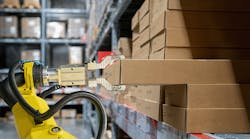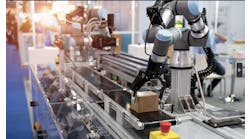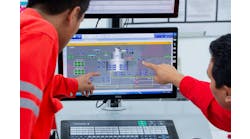Chris Cacioppo is CTO and co-founder of 6 River Systems.
What sorts of sensing technologies have improved the effectiveness and reliability of picking systems and conveyance systems?
Chris Cacioppo, CTO and co-founder, 6 River Systems: Sensors have been crucial for the safe implementation of autonomous mobile robots (AMRs). Warehouses use mapping through light-detection-and-ranging (LIDAR) sensors to allow collaborative robots like 6 River Systems’ Chuck to safely navigate warehouse floors on their own, without the need for an associate to push or pull the heavy carts. Similar to the sensing technology used in automated vehicles, collaborative robots can travel through work zones while remaining aware of the space around them. Employee safety is the first priority when using automation, so sensing technology must be accurate to ensure the safety of the associate using the robots and everyone around them on the warehouse floor.
Also read: 3 keys to successful AMR deployments
As warehouse distribution centers continue to grow larger, how are tracking and intelligence helping to keep up with customer demands?
Chris Cacioppo, CTO and co-founder, 6 River Systems: Warehouse management and automation systems have a number of tools that support keeping up with customer demands. Electronic data interchange (EDI) helps to scale automation by automating transactions to follow rules or patterns. This limits errors and mistakes, while helping to streamline and support omnichannel commerce. Radio-frequency identification (RFID) tracks objects within a warehouse in real-time. RFID tags on products or cases can be monitored throughout the process eliminating the need for barcodes, scanners or line of sight to the product. This data helps to make improvements and accuracy for fulfillment solutions.
Artificial intelligence (AI) and machine learning also allow for dynamic zoning, which updates associates’ working areas in real time depending on the profile of work that needs to be completed. It’s also important for warehouses to have visibility into operations to increase efficiency. To achieve this, warehouse operators should look for overarching tools that connect the data from what’s happening on the ground in a physical warehouse operation to an intuitive cloud-based control center.
Which technologies have allowed warehouses to increase throughput rates while expanding product ranges and still maintaining accurate order fulfillment?
Chris Cacioppo, CTO and co-founder, 6 River Systems: Using mixed-mode picking with collaborative robotics has allowed warehouses to increase throughputs while maintaining accuracy. This allows the collaborative robots to perform order picking, batch picking, singles picking and zone picking. Picking modes can be dynamically switched based on the type and priority of orders. This capability optimizes throughput and service-level agreements (SLAs) while increasing pick accuracy.
Because of the warehouse’s physical nature, how much of the facility’s hardware can be replaced with software in order to facilitate easier upgrades, expansions and reconfigurations?
Chris Cacioppo, CTO and co-founder, 6 River Systems: Both hardware and software are equally crucial components to any warehouse’s fulfillment solution. The software functions as the brain of the solution, making it the key to the hardware performing as efficiently as possible over time. Investing in software that allows for continuous improvement and actionable insights will help associates and warehouse managers to get the most out of the entire solution.
Will autonomous mobile robots replace automated guided vehicles altogether, or is there room for both, based on the application or complementary functions?
Chris Cacioppo, CTO and co-founder, 6 River Systems: Both autonomous mobile robots and automated guided vehicles (AGVs) serve different functions to accomplish unique tasks, so there is room for both in the warehouse space. AGVs, such as self-driving forklifts, transport inventory from one location to another within the warehouse. Autonomous mobile robots are similar to AGVs, in that they transport inventory and materials throughout a warehouse autonomously. Unlike AGVs, which travel fixed routes guided by tracks or magnetic strips, AMRs rely on maps and sensors to navigate more flexible routes by interpreting the environment. Autonomous inventory robots are one type of autonomous mobile robots. When used with RFID-tagged equipment and items, autonomous inventory robots conduct inventory counts at predetermined times or intervals. Automated guided vehicles are a better fit for movement of larger materials or pallet handling, while autonomous mobile robots are usually best leveraged for picking of smaller items.
Given the extraordinary percentage of manual operation in most distribution centers, will the 24/7 fully autonomous warehouse order-fulfillment center ever become commonplace?
Chris Cacioppo, CTO and co-founder, 6 River Systems: It’s unlikely that the 24/7 fully autonomous warehouse order-fulfillment center will become commonplace in the near future. This is largely because a common concern with fully autonomous robots is that these technologies still make errors and aren’t equipped to recover from them without human intervention. For example, if a package is dropped on the floor, most systems are not able to move it or clean it up automatically. If that dropped package is blocking a critical area of the warehouse, it will create a chain reaction of issues. Even if a fully automated system is 99.9% problem-free, it will still make about 10 unrecoverable errors per day in a warehouse shipping 10,000 units per day.
One of the most popular automated robots we’re seeing in warehouses is the collaborative mobile robot, which works alongside humans to enhance their efficiency and ease the physical labor strain during the picking process. While the associate is still needed to do the picking, the collaborative robots optimize pick routes by guiding them through their work zones, reduce walking, eliminate pushing heavy carts and reduce errors. Collaborative robots offer the flexibility to add and remove robots based on volume and available labor. As labor shortages continue to raise issues among warehouses, collaborative robots offer a solution that will assist available staff without requiring major changes to infrastructure like a fully autonomous fulfillment center would. There are some tasks, however, that can be fully automated 24/7 such as picking a high volume of items.






